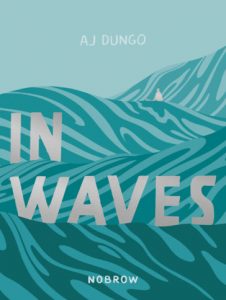 A.J. Dungo is the author and artist of the graphic novel, In Waves. It is a personal narration of a chain of vignettes that cover a lot of territory: it’s a coming of age story, historical brief on surfing culture, cameos of two major surfing icons, love story, and emotional and philosophical repose on significant moments in author’s life. Besides the narrator, the other main characters are Kristen (the woman he loved), Duke Kahanamoku (Hawaiian Oympic athlete and surfer) and Tom Blake (surfing legend and innovator).
A.J. Dungo is the author and artist of the graphic novel, In Waves. It is a personal narration of a chain of vignettes that cover a lot of territory: it’s a coming of age story, historical brief on surfing culture, cameos of two major surfing icons, love story, and emotional and philosophical repose on significant moments in author’s life. Besides the narrator, the other main characters are Kristen (the woman he loved), Duke Kahanamoku (Hawaiian Oympic athlete and surfer) and Tom Blake (surfing legend and innovator).
Dungo’s simple but evocative renderings of historic black and white photos, film, and interpretations of recollections of real-life scenarios often have a woodcut quality to them. They capture a kind of timeless quality that lends itself to introspection as one reads through it.
The opening chapter is entitled: “Origins” and is set in spring in the year 1800 in the Hawaiian islands. “Surfers have always found solace in the water,” it begins. The panel has a drawing of a singular female surfer sitting on an ancient carved wooden surfboard, the grain in the wood reflecting the ripples in the water and the furrows of the mountains.
Moving forward, several stories unfold. Sometimes the stories seem unconnected, other times intersecting, sometimes revealing flashbacks in time. The different stories help hold interest especially to the non-surfer and those who may find Bungo’s personal story a little discomforting. That is because early on you realize that this graphic novel would be about (at least in part) the story of a young woman facing her difficult and impending death and how it affects the people around her.
Dungo tempers that provocative story carefully, interposing the stories of Duke Kahamoku and the early days of Hawaiian surfing and visitor culture and Tom Blake’s early life journeys, discoveries and innovations.
Dungo makes this comment about the change in Hawai`i ’s beaches from an indigenous cultural environment to a commercial destination: “Over time the shade trees were replaced by the shadow of structure…”
The flashbacks, both historical and personal, seem to pose the question to the reader: What is history without subjective interpretation? What informs and influences our perspectives on past events and even our own most personal experiences? How does history shape our present moment and future vision? What can be learned from history?
As Kristen lays in a hospital bed, her cousin goes surfing and waits for a wave and reflects about surfing in the warm sunshine in the carefree days past:, “…There was never a sense of urgency… or thinking time was too short… Those are the days.” As nostalgia is often a caricature of history, I wondered if regrets are a re-editing of history.
Woven throughout the narrative is the idea that the ocean – and specifically its waves – offers to surfers (and whoever might involve themselves in its motion and action) not only the obvious splash of exhilaration and pleasure, but also the waves can offer comfort from pain, a refuge from turmoil and perhaps even a source of renewal.
Duke Kahanamoku, Tom Blake and A.J. Dungo have all experienced the life analogies of surfing a wave… waiting for and choosing an approaching wave, the anticipation of possibilities, committing oneself to catching its power, and once up and riding, then maintaining balance and direction with grace in the face of falling. Once the ride is complete and the waves dies out, what next?
Not everything in life happens according to plan. Not everything turns out good. Broken dreams and unfulfilled expectations are things everyone faces in life. As the novel nears its ending, I thought: “How will the topic of heart break and grief be dealt with?”
Dungo talks about his grief of Kristen’s death as coming in waves… “It comes in and goes… brewed by a storm in the distant deep in the ocean… churning… surging… rushing… then the water retreats only to begin again.” Seems to me also that can be a description of joy and hope. Perhaps that is my own reinterpretation of history.
A.J. Dungo tells several stories in In Waves that are from different times and places. But in his telling, he was able to connect to the stories of my life, and I believe it will be so for you also, whether you are a surfer or not. And when that happens, I think there is a place where your heart is tender and aches a little with feeling someone else’s pain, and then we feel our own.
A.J. Dungo’s closing words are an invitation to being completely in the moment, yet breathing deep the lilting fragrance of those shining moments of truthful living pulsing with something universal and eternal.





Recent Comments